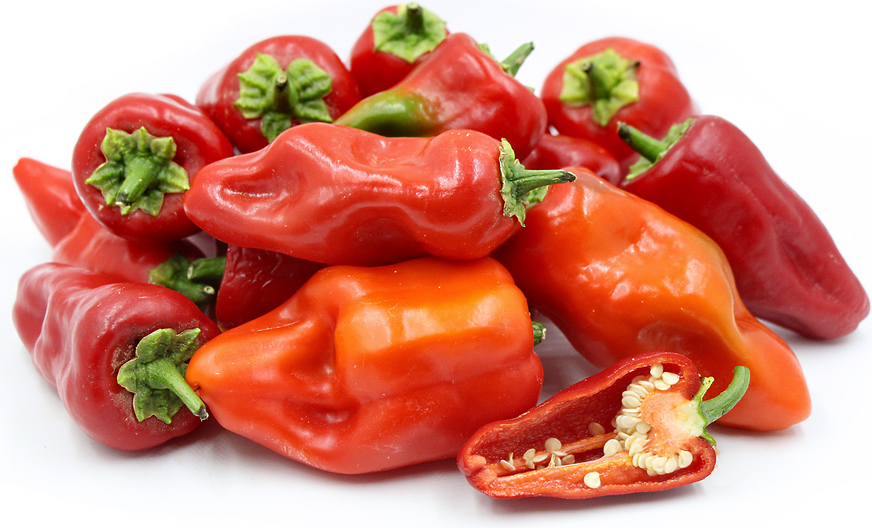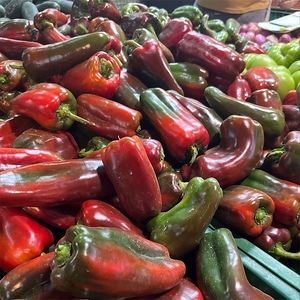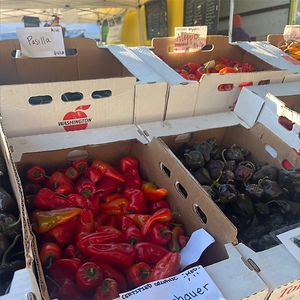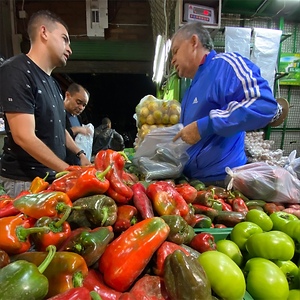


Leutschauer Paprika Chile Peppers
Estimated Inventory, lb : 0
Description/Taste
Leutschauer paprika chile peppers are broad, crinkled pods, averaging 7 to 10 centimeters in length and 2 to 5 centimeters in diameter, and have a conical shape that tapers to a rounded point on the non-stem end. The skin is glossy, smooth, and firm, ripening from green to bright red when mature, and the pods may bear deep dimples and creases across the surface. Underneath the skin, the flesh is thin, crisp, pale green to red, and aqueous, encasing a central cavity filled with round and flat, cream-colored seeds. Leutschauer paprika chile peppers, when fresh, are sweet with a mild heat, and in their dried form, they develop a smoky, sweet, and spicy flavor.
Seasons/Availability
Leutschauer paprika chile peppers are available in the mid-summer through fall.
Current Facts
Leutschauer paprika chile peppers, botanically classified as Capsicum annuum, are a rare heirloom variety of paprika pepper that belongs to the Solanaceae or nightshade family. The peppers have a mild heat, reaching no more than 1,000 SHU on the Scoville scale, and are named after their native region of Leutschau, Slovakia. Leutschauer paprika chile peppers are difficult to find outside of Slovakia as they are not commercially produced, but some small specialty farms and home gardeners in the United States are experimenting and growing the variety for its prolific pods and resistance to disease. In Europe, Leutschauer paprika chile peppers are traditionally dried and used to make spicy paprika.
Nutritional Value
Leutschauer paprika chile peppers are an excellent source of vitamin C, which is an antioxidant that can help repair damage within the body and boost the immune system. The peppers also contain vitamin A, and the bright red pigmentation of the pepper comes from phytonutrients in the flesh known as carotenoids, which provide strong antioxidant and anti-inflammatory benefits.
Applications
Leutschauer paprika chile peppers are best suited for both raw and cooked applications such as sautéing, baking, and roasting. When fresh, the peppers can be chopped and tossed into salads, stuffed with dips, cheeses, and grains and baked, or sliced and sautéed as a simple side dish. Leutschauer paprika chile peppers can also be cooked into a pepper jelly, roasted for a smoky flavor, or roasted, pureed, and served in sauces such as coulis. In addition to using fresh, the peppers are popularly dried, ground into a powder, and utilized as a spicy paprika powder. Leutschauer paprika chile peppers pair well with meats such as beef, poultry, pork, and lamb, potatoes, carrots, celery, cabbage, onions, garlic, cherries, apples, noodles, poppyseeds, and sour cream. Fresh peppers will keep 1-2 weeks when loosely stored whole and unwashed in a paper or plastic bag in the refrigerator. Dried Leutschauer paprika chile peppers will keep up to six months when stored in a cool, dry, and dark place.
Ethnic/Cultural Info
In Europe, Leutschauer paprika chile peppers are predominately dried and used to make spicy paprika. The globally famous, pigmented powder was first named paprika in the late 19th century and was a derivative of the Croatian word papar and the Greek word peperi, both meaning pepper. Paprika is a general term used to describe powders made from many different varieties of dried pepper. Families across Europe have secret recipes with varying ingredients and traditionally make their own paprika from peppers grown in their home gardens. In Slovakia, Leutschauer paprika chile peppers are traditionally used as a spice in kapustnica, which is cabbage soup and in Gulášová polievka or goulash, which is a soup made from tomatoes, peppers, garlic, onions, beef, and potatoes.
Geography/History
Leutschauer paprika chile peppers are native to Leustchau, Slovakia, and are descendants of peppers from Central and South America. The original varieties of Central and South American peppers were introduced to Europe via Spanish and Portuguese explorers during the 15th and 16th centuries, and as peppers were established in Eastern Europe, new varieties were bred such as the Leutschauer paprika chile pepper for flavor and appearance. Leutschauer paprika chile peppers were also brought south to the small city of Matrafured in the Matra mountains of northern Hungary in the 1800s, where it is still widely grown today. Leutschauer paprika chile peppers can be found through small farms and online seed catalogs for home garden use in Europe and the United States.










